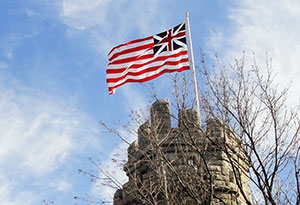 *
*
By J. L. Bell: Correspondent for Off the Shelf
The raising of the “Grand Union Flag” on Prospect Hill in January 1776 is a proud historic moment for Somerville. But a lot of mysteries still surround that event.

The standard story is that after the Continental Congress established a navy in October 1775, it also approved a flag for that navy. Under the rules of war, a ship had to fly its country’s flag as it went into battle (though it could maneuver under a “false flag” until that moment). Some American warships were sailing under banners produced by individual states, but the Congress’s fleet needed its own ensign.
The design provided for the Continental Navy had the Union Jack in the upper left corner with thirteen red and white stripes below. Ships in the Chesapeake Bay flew this emblem by December. Britain’s Royal Navy fought under a similar flag: a Union Jack over a solid red field.
Meanwhile, up in Massachusetts, most Continental Army soldiers’ enlistments were running out. The New England men who had begun the siege of Boston in April 1775 had promised to serve only through December. Working from his headquarters in Cambridge, General George Washington oversaw a tense process of convincing some troops to reenlist, recruiting more, and reorganizing the regiments that remained.
To celebrate the relaunch of the Continental Army, Washington wrote, “we had hoisted the Union Flag in compliment to the United Colonies.” This banner appeared above Prospect Hill, center of one of the besieging army’s largest camps. A couple of days later, the general heard that British officials in Boston had interpreted this new flag, so like their own, “as a signal of Submission.” But they soon learned the Continentals would fight on.
Here are questions about this event with no definite answers in the surviving historical records.
Who designed the new Continental Navy flag? The Congress’s papers don’t say. We therefore don’t know what the delegates meant by authorizing a flag so similar to the British navy’s banner. We can guess it symbolized how they weren’t yet ready for a complete break with Britain. The thirteen stripes surely represented the thirteen colonies at that Congress, though delegates hoped to add Canada to the mix.
Was the Continental Navy flag the same as Washington’s “Union Flag”? For decades, the phrase “Union flag” had referred to the British flag, symbolizing the union of England and Scotland. Washington saw his “Union Flag” as honoring the thirteen united colonies. Two British witnesses inside Boston, a ship captain and a marine officer, wrote of seeing a new “Union flag” over the Americans’ camp, but they left no clear description of that banner. Most historians, but not all, conclude that this was the Continental Navy flag.
How did Washington receive the new flag? The Congress never voted to send its naval flag to its army commander. No document shows a flag being transported from Philadelphia to Cambridge. The most likely candidate for sending the banner is Joseph Reed, a Philadelphia lawyer who had been Washington’s military secretary in the summer and early fall. Washington wrote to Reed on January 4 describing how the army had flown the new flag. Unfortunately, Reed’s letters to Washington in this period went missing after the two men had a falling-out in late 1776.
Who reported on the new flag in the January 15 Pennsylvania Packet newspaper? A compilation of news from the Continental Army camp described how “the great Union flag was hoisted on Prospect-Hill.” This is the evidence locating the flag at that site since Washington’s letter and the British observations did not specify a place. However, that article also stated that event occurred on January 2, not January 1. Again, Reed seems like the best candidate for writing this report since he adapted some of the general’s other letters for the newspapers. But he should have known the right date.
Did British officials really think the flag meant the rebels were ready to surrender? No source from inside Boston suggests that. Instead, the ship captain and marine officer both described the new flag as a signal of defiance. Washington said he heard about the expectations of surrender from “a person out of Boston last Night.” Also on January 4, the general reported information he had recently received from “a very Intelligent Gentleman, a Mr Hutchinson from Boston” – perhaps merchant Shrimpton Hutchinson. He may have told a different story about reactions to the flag.
Where did the label “Grand Union Flag” come from? Washington called the new banner “the Union Flag.” The Pennsylvania Packet called it “the great Union flag,” as did other newspapers reprinting the same article. So where did the present term come from? In 1852 the Philadelphia journalist Thompson Westcott wrote to the London magazine Notes and Queries with information about early American flags. Among other things, he quoted the Pennsylvania Gazette as reporting, “The grand union flag was raised on the 2nd.” This was an error for the phrase that had appeared in newspapers in 1776, but the word “grand” was repeated by other magazines and eventually the flag historian George Henry Preble.
Thus, we probably owe the resonant phrase “Grand Union Flag” to a transcription error seventy-six years later.
L. Bell is the author of The Road to Concord: How Four Stolen Cannon Ignited the Revolutionary War (Westholme, 2016). He maintains the Boston1775.net website, dedicated to history, analysis, and unabashed gossip about the start of the American Revolution in New England.















Reader Comments